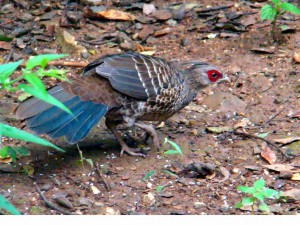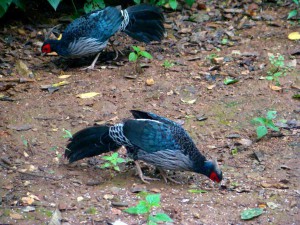
White-crested Kaleej
The White-crested Kaleej (Lophura leucomelanos hamiltonii) is a striking subspecies of the Kalij Pheasant, found in the lower Himalayan forests. In the Great Himalayan National Park (GHNP), this elusive bird inhabits the dense undergrowth of oak and rhododendron forests, where its bold black-and-white plumage and wary behavior make it a treat for birdwatchers lucky enough to spot it.
Identification and Appearance
The White-crested Kaleej is known for its distinctive white crest, glossy bluish-black plumage, and white streaks across the upper body. Males are larger and more vividly colored, while females are browner with subtler markings, offering better camouflage in the forest understorey.
Habitat and Range in GHNP
This subspecies is commonly found in lower to mid-elevation zones, typically between 1,200 and 2,400 meters in GHNP. It prefers dense forests, thick shrubs, and bamboo patches, especially near water sources or forest clearings.
Behavior and Ecology
The White-crested Kaleej is mostly ground-dwelling, foraging quietly in the leaf litter for insects, seeds, berries, and shoots. It is a shy and alert bird that often retreats into thick vegetation at the slightest disturbance. During dawn and dusk, its presence may be betrayed by a series of sharp, grating calls or by brief glimpses as it scuttles across forest trails.
Breeding Season
Breeding typically occurs from April to July. The male may be seen displaying to females by fanning his tail and raising his crest. The nest is usually a simple scrape on the ground, hidden among vegetation, where the female lays 4–6 eggs.
Conservation Status
Although not currently considered threatened, the White-crested Kaleej faces pressure from habitat loss, poaching, and human disturbance in some areas. GHNP’s strict conservation measures help preserve a safe habitat for this shy species, which is also listed under Schedule I of the Indian Wildlife Protection Act.
Birdwatching Tips
To spot this bird, explore forest trails near Rolla, Shilt, or the Sainj Valley, especially in the early morning. Patience and silence are key, as the White-crested Kaleej is quick to vanish into the underbrush.




